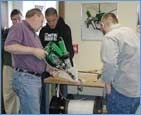By Larry Rowold, The Plastics Welding School
I have, for the past several years, been teaching Concrete Protective Liner welding and Geomembrane welding both for novice welders and “old timers”. During the classroom portion, we discuss the basics of plastics, which are weldable and the basics of the welding equipment we will be using, also what is required to make a successful weld. Once we begin the welder testing portion the old adage that I mention at the beginning of each test session almost always becomes fact. That is that the person who has been welding the longest usually is the first to fail or the last one to pass the examinations.
 The more years we do plastic welding the more we lose concentration on the basics taught to us “oh so many years ago”. We tend to concentrate more on the need to get the job or weld done quickly because time is money. We know subconsciously that the most expensive bad welds are those we have to re-weld after the project is finished or are discovered during the final inspection, or in the worst case, begins leaking after the structure is put into full operation, when all the equipment is at another job site and the welders are in another state.
The more years we do plastic welding the more we lose concentration on the basics taught to us “oh so many years ago”. We tend to concentrate more on the need to get the job or weld done quickly because time is money. We know subconsciously that the most expensive bad welds are those we have to re-weld after the project is finished or are discovered during the final inspection, or in the worst case, begins leaking after the structure is put into full operation, when all the equipment is at another job site and the welders are in another state.
There are several reasons for this:
- We take short cuts on the preparation; we do not wipe down the weld area to make sure it is free of any form of liquids or hydrocarbons such as water, form oils, sling or lifting strap greases, etc.
- We do a quick passover with the sanding disc, we do not take the time to make sure that we have removed all the oxidized area and are welding virgin material.
- We think we can weld over the “ever so slight damp spot”, knowing that moisture and plastic welds do not go together. We know that we have to have a clean dry weld area if the weld is to be good.
- We think we do not need to preheat the beginning of the weld area; we can just pick up the extrusion welder and begin the weld. We need to take the extra 5-10 seconds to let the preheat soak into the initial weld area and this will carry forward for the whole weld.
- We think we do not need to purge the extrudate from the welder shoe; we do not need to preheat the weld shoe. Anytime we pick up an extruder after it has been sitting we need to purge the extrudate from the barrel: at least the material that is forward of the heat blanket approximately three to four inches.
- We think we can use just any welding rod, even the welding rod that has been sitting in the back of the truck during the rain the night before. Welding rod has to be treated with care. It needs to kept clean and dry, try putting each roll in a kitchen garbage bag when in storage. Have you ever had the weld area “pop” back at you when welding, or shown signs of dimples – you may have damp welding rod.
I have on many occasions had an examinee or welder fail a coupon test due only to two things (assuming that he has his temperatures set correctly): not purging his welder and not counting to ten with his preheat. If he had done these, his test results would have been good.
The views, opinions and technical analyses presented here are those of the author or advertiser, and are not necessarily those of ULProspector.com or UL Solutions. The appearance of this content in the UL Prospector Knowledge Center does not constitute an endorsement by UL Solutions or its affiliates.
All content is subject to copyright and may not be reproduced without prior authorization from UL Solutions or the content author.
The content has been made available for informational and educational purposes only. While the editors of this site may verify the accuracy of its content from time to time, we assume no responsibility for errors made by the author, editorial staff or any other contributor.
UL Solutions does not make any representations or warranties with respect to the accuracy, applicability, fitness or completeness of the content. UL Solutions does not warrant the performance, effectiveness or applicability of sites listed or linked to in any content.


